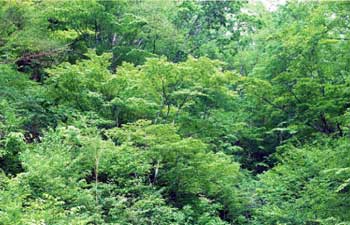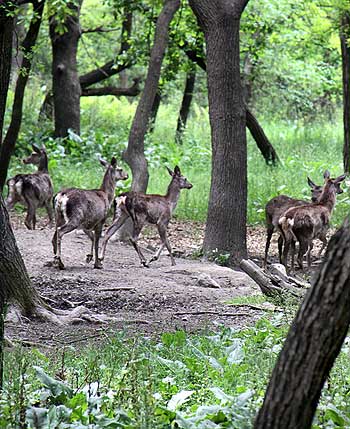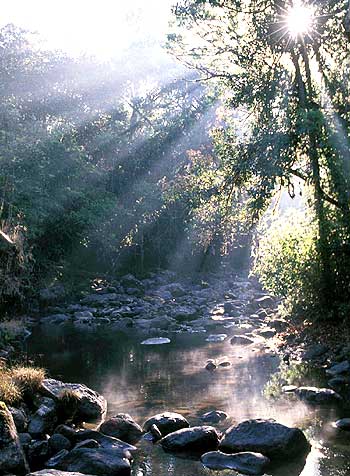Photographs: Ministry of Environment and Forests
Here, Minister of State Environment and Forests Jairam Ramesh explains how the forest cover of India will help.
In India, we consider our forests a unique national treasure. Forests are responsible for India's rich biodiversity -- India is one of the 12 "megadiverse" countries in the world.
Our forests hold within them unique wildlife, flora and fauna, and are also a source of sustainable livelihoods to over 200 million people in our country.
It is therefore not surprising that we take our commitment to protecting, regenerating and growing our forests very seriously. India has a great tradition of institutionalised scientific forest conservation dating back 142 years, when the Imperial Forest Service was established in 1867.
We also have one of the most progressive forest conservation legislations in the world, which puts severe restrictions on diversion of forest land for non-forestry purposes.
It is the result of these efforts that despite our rising population and the pressures of economic development, India is one of the few developing countries where the forest cover has increased over the last 20 years and continues to increase -- today, more than a fifth of India's land area is under forest cover.
This is something that we are proud of, and intend to maintain and grow. We have taken a number of recent initiatives in this direction, including the launch of a landmark fund for the regeneration and sustainable management of our forests with an initial corpus of $ 2.5billion, as well as an annual budget of about $ 1 billion.
Forestry is at the centre-stage of global climate change negotiations. This is because forests have the potential to be a carbon sink as well as a source of carbon emissions.
We are actively participating in the discussions on forestry that are taking place under the Bali Action Plan and the United Nations Framework Convention on Climate Change.
It is India's view that we need an agreement on a comprehensive framework for compensation and positive incentives for forestry as part of the ongoing climate change negotiations.
I hope that this publication will provide a useful snapshot of the carbon value of India's forests, and give a glimpse of the potential of India's forests to offset India's and the world's carbon emissions.
India's Forest and Tree Cover: Contribution as a Carbon Sink
Image: Kashmiri red deer Hangul seen in the Dachigam Wildlife sanctuary on the outskirts of SrinagarPhotographs: Reuters
India's Forest Cover accounts for 20.6% of the total geographical area of the country as of 2005. In addition, Tree Cover accounts for 2.8% of India's geographical area.
Over the last two decades, progressive national forestry legislations and policies in India aimed at conservation and sustainable management of forests have reversed deforestation and have transformed India's forests into a significant net sink of CO2.
From 1995 to 2005, the carbon stocks stored in our forests and trees have increased from 6,245 million tonnes (mt) to 6,662 mt, registering an annual increment of 38 mt of carbon or 138 mt of CO2 equivalent.
Mitigation Service by India's Forest and Tree Cover
India's forests serve as a major sink of CO2. Our estimates show that the annual CO2 removals by India's forest and tree cover is enough to neutralize 11.25 % of India's total GHG emissions (CO2 equivalent) at 1994 levels, the most recent year for which comparable data is available for developing countries based on their respective National Communications to the United Nations Framework Convention on Climate Change.
This is equivalent to offsetting 100% emissions from all energy in residential and transport sectors; or 40% of total emissions from the agriculture sector. Clearly, India's forest and tree cover is serving as a major mode of carbon mitigation for India and the world.
Carbon Stocks in the Future
Image: India is one of the few developing countries where the forest cover has increased over the last 20Photographs: Ministry of Environment and Forests
Based on actual and projected trends of investments in the forestry sector, we present three scenarios of the future carbon stocks in the forest and tree cover of India.
In the first scenario, the carbon stocks in India's forest and tree cover decrease at the rate of the world average4 . Under this scenario, the total carbon stored in India's forests in 2015 will decrease to 6,504 mt.
In the second scenario, the carbon stocks in India's forest and tree cover continue to increase at the historical rate of the last decade (0.6% p.a.).
Under this scenario, the total carbon stored in India's forests in 2015 will increase to 6,998 mt.
1 Forest cover in India is defined as all lands, more than one hectare in area with a tree canopy density of more than 10%.
2 Tree Cover is defined as tree patches outside recorded forest areas exclusive of forest cover and less than the minimum mappable area of one hectare.
3 The Second National Communication, a comprehensive inventory of India's Greenhouse Gases, is under preparation and will be available by November 2010. This will provide data up to 2000 as required by UNFCCC.
4 Assuming the same rate of decline in forest and tree cover as the world average between 2000-2005 (0.18% p.a.); Source: FAO, State of the World's Forests, Rome, 2005 India's Forest and Tree Cover: Contribution as a Carbon Sink.
'The path we intend to tread in India'
Image: Carbon stocks in India's forest and tree cover increase at a rate higher than historical ratePhotographs: Rediff Archives
Under this scenario, the total carbon stored in India's forests in 2015 will increase to 7,283 mt. This is the path that we intend to tread in India. India has launched a series of progressive policy initiatives on Sustainable Management of Forests as well as Afforestation and Reforestation, which involve significant additional resources for sustaining and growing India's forest cover.
This includes the world's largest Forest Restitution Fund5 with $ 2.5billion as of June 2009, which is being deployed for SMF and A&R programmes, as well as a policy to include forestry related activities in the flagship employment scheme of the country.
It also includes introducing new forestry related schemes on components such as capacity building in the forestry sector. These measures will provide annual public expenditure of $ 1billion on forestry related activities. This will lead to an increase in the quality and density of India's forests, as well as in the rate of increase of India's forest and tree cover. This explains the basis of the computation of carbon stocks in scenario three.
Value of Mitigation
Putting a conservative value of $ 5 per tonne of CO2 locked in our
forests, this huge sink of about 24,000 mt of CO2 is worth $ 120billion, or Rs 6,00,000 crores.
Incremental carbon under scenario three will add a value of around $ 1.2billion, or Rs 6,000 crores every year to India's treasury of forest sink, assuming a value of $ 7 per tonne.





article